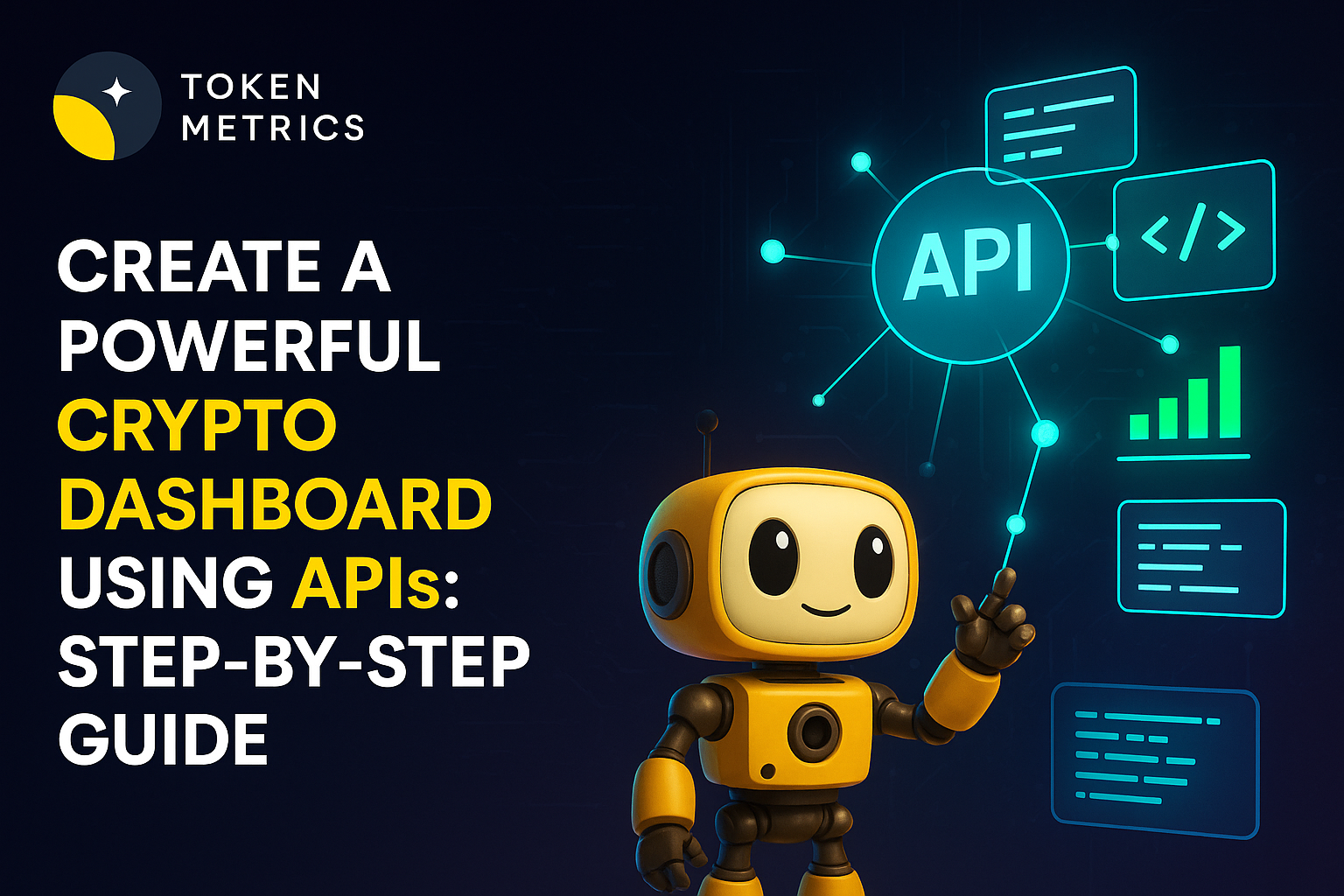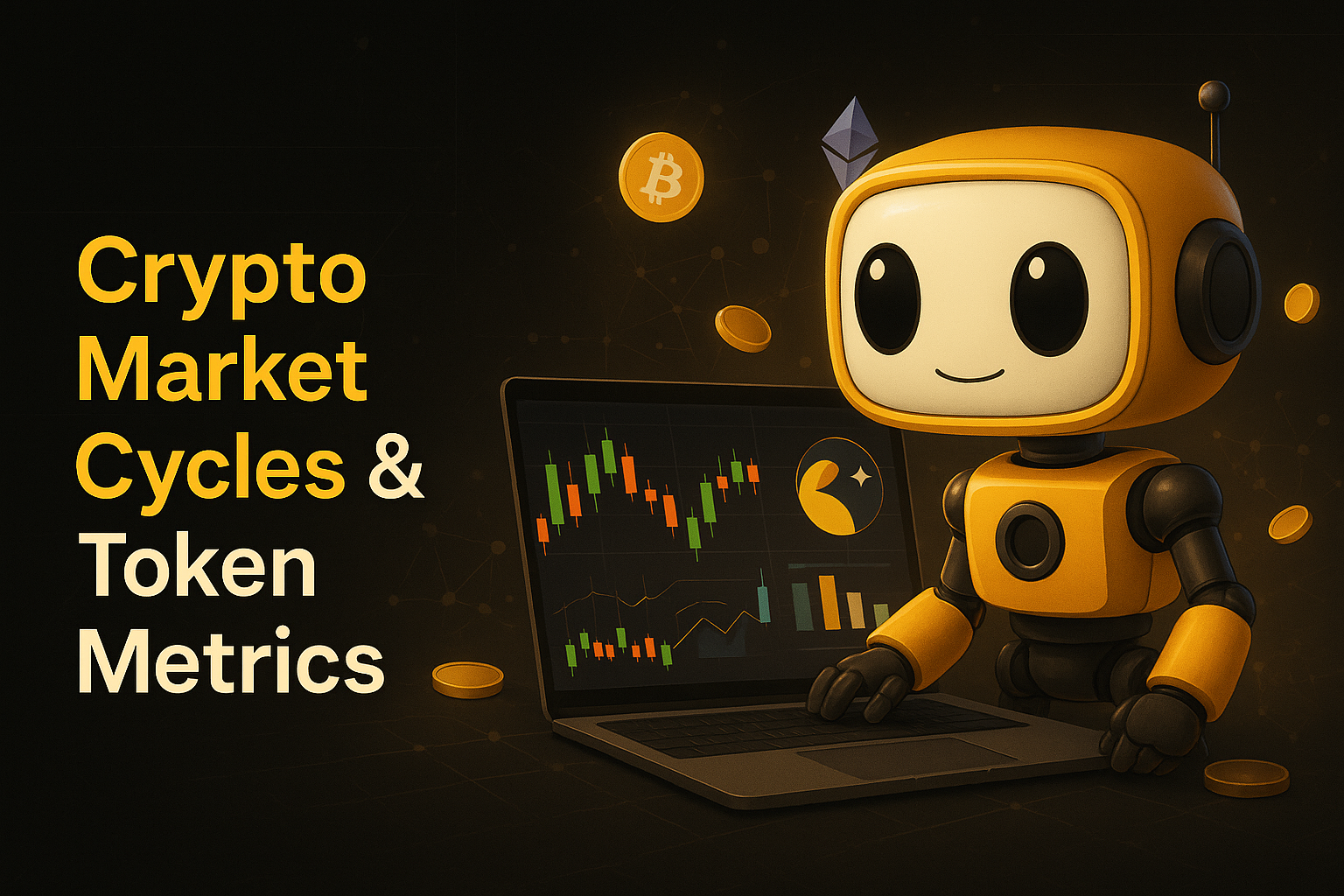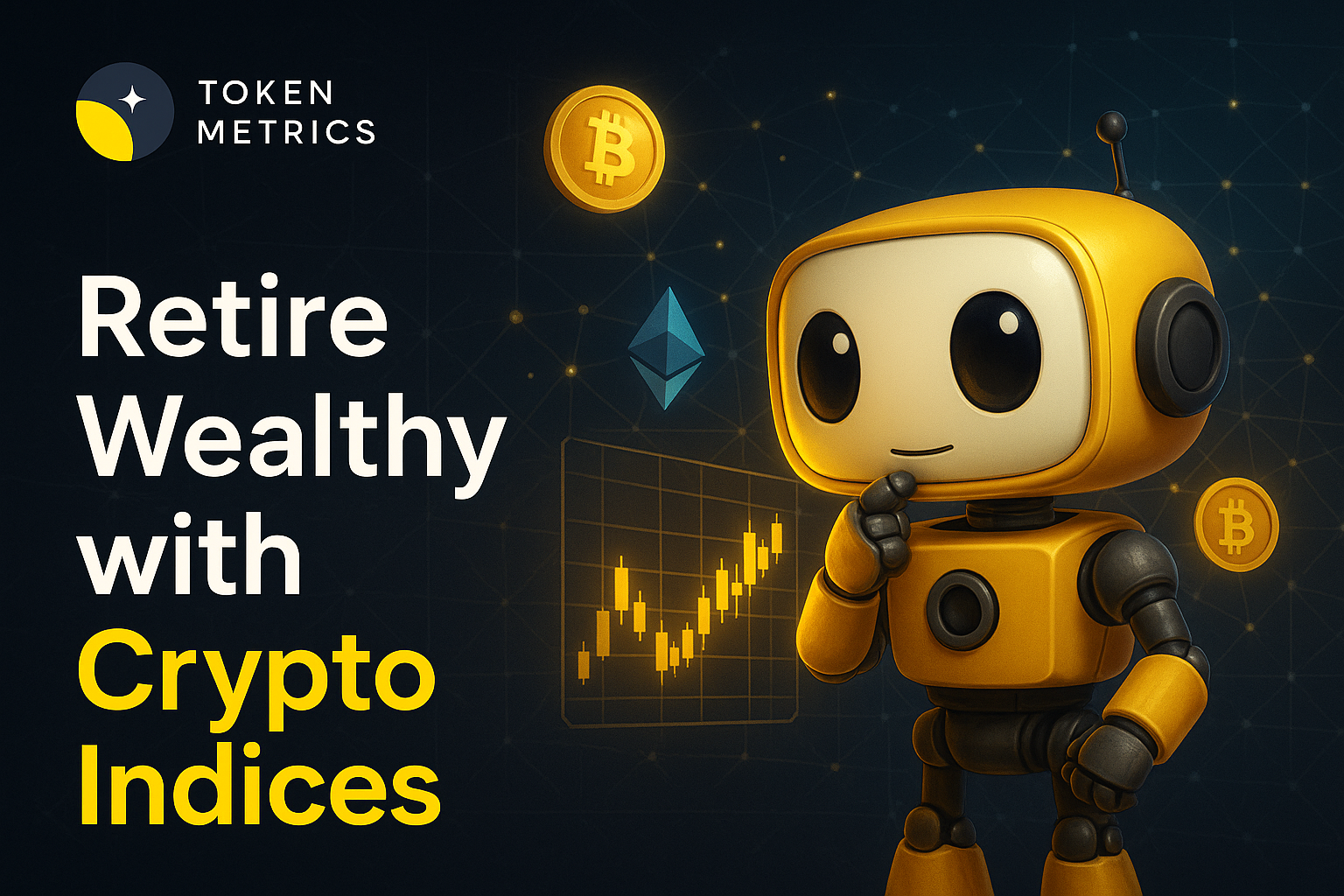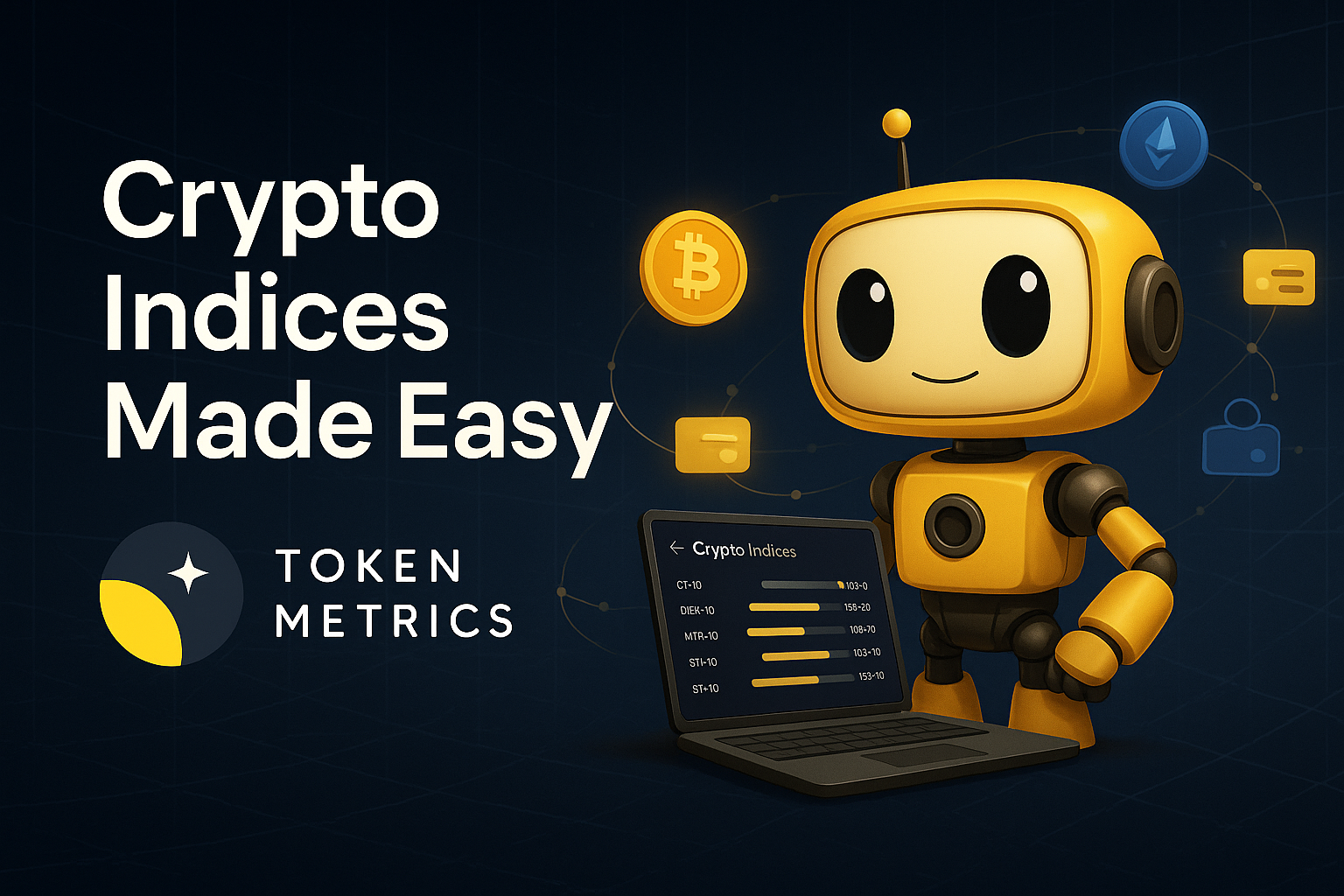Cryptocurrency markets move through distinct cycles—explosive bull runs, devastating bear markets, and frustrating sideways consolidation. Most investors struggle because they employ the same strategy regardless of market conditions, buying aggressively during euphoric peaks and panic selling during despair-filled bottoms.
Professional investors adapt strategies to market conditions, allocating aggressively during fear, taking profits during greed, and maintaining patience during consolidation. Token Metrics AI Indices provide the framework for implementing cycle-aware strategies that maximize returns across all market environments.
This comprehensive guide explores how to recognize different market phases, adjust index allocations for each condition, implement tactical strategies that capitalize on market cycles, and maintain long-term discipline while navigating volatility.
Understanding Cryptocurrency Market Cycles
Before adjusting strategies, you must recognize which market phase is occurring. Crypto markets exhibit more dramatic cycles than traditional assets, creating both risk and opportunity.
Bull Market Characteristics
Bull markets feature sustained upward price momentum across most cryptocurrencies, with several identifying characteristics:
- Bitcoin and major altcoins achieving new all-time highs
- Widespread mainstream media coverage of crypto success stories
- New investors entering the market in accelerating numbers
- Trading volumes increasing substantially across exchanges
- Social media sentiment overwhelmingly positive and euphoric
- New projects launching successfully with strong investor demand
- Fear & Greed Index consistently showing "extreme greed"
Bull markets typically last 12-24 months and generate life-changing returns for positioned investors. Bitcoin's 2020-2021 bull run saw gains exceeding 1000%, with many altcoins appreciating even more dramatically.
Bear Market Characteristics
Bear markets feature sustained downward pressure with pessimism dominating sentiment:
- Major cryptocurrencies declining 70-90% from peak values
- Mainstream media declaring crypto "dead" or discussing collapse
- Retail investors capitulating and exiting positions at losses
- Trading volumes declining as interest wanes
- Social media sentiment turning negative and fearful
- Project failures and exchange bankruptcies making headlines
- Fear & Greed Index showing "extreme fear" for extended periods
Bear markets typically last 12-18 months and test investor resolve severely. The 2022 bear market saw Bitcoin decline 75% with many altcoins losing 90%+ of value.
Sideways/Consolidation Market Characteristics
Consolidation phases feature range-bound trading without clear directional trends:
- Prices oscillating within defined ranges for extended periods
- Minimal mainstream media coverage as crypto becomes "boring"
- Retail interest declining but not capitulating completely
- Trading volumes moderate and stable
- Social media sentiment neutral without extreme fear or greed
- Market "digesting" previous moves and building support levels
Consolidation periods last weeks to months, often preceding major directional moves. These phases frustrate momentum traders but reward patient, strategic investors.
Bull Market Index Strategies: Maximizing Upside Capture
Bull markets offer the greatest wealth creation opportunities. Proper positioning during these phases generates returns funding years of conservative investing.
Aggressive Allocation During Early Bull Markets
When bull market indicators emerge, increase crypto index allocation aggressively. Early bull market phases offer the best risk/reward as prices remain relatively low while momentum builds.
If your standard allocation is 10% crypto, consider increasing to 15-20% during confirmed bull market starts. This tactical overweight positions you to capture maximum appreciation during the explosive middle phase.
Focus allocation on aggressive growth indices targeting smaller-cap tokens with highest upside potential. These indices typically outperform conservative alternatives 2-3x during bull runs. A balanced approach might look like:
- 40% Aggressive Growth Indices (small/mid-cap focus)
- 30% Balanced Indices (diversified exposure)
- 20% Sector-Specific Indices (DeFi, Layer-1, AI tokens)
- 10% Conservative Indices (downside protection)
Systematic Profit-Taking During Peak Euphoria
As bull markets mature and euphoria intensifies, implement systematic profit-taking to lock in gains. The greatest mistake investors make is riding entire rallies up and back down without realizing profits.
When Fear & Greed Index shows "extreme greed" for consecutive weeks and mainstream media features crypto prominently, begin taking profits. Don't try timing exact tops—instead, implement scaling strategies:
- Sell 10% of crypto holdings when portfolio gains exceed 100%
- Sell another 10% when gains exceed 200%
- Sell another 15% when gains exceed 300%
- Sell final 15% when gains exceed 500% or signs of reversal appear
This approach locks in life-changing gains while maintaining exposure if bull market extends further. You'll never sell at the exact top, but you'll capture substantial profits systematically.
Rebalancing Discipline Prevents Overexposure
Bull markets can cause crypto allocation to grow from 10% to 30-40% of total portfolio as values appreciate. This creates dangerous overexposure to a single asset class.
Rebalance quarterly during bull markets to maintain target allocation ranges. If crypto grows from 10% to 25% of portfolio, sell enough to return to 15% target (allowing modest overweight during favorable conditions). Redeploy profits into uncorrelated assets like bonds or real estate.
This disciplined rebalancing forces "buy low, sell high" behavior—selling appreciating crypto to buy lagging assets that may outperform in next cycle.
Avoid FOMO-Driven Purchases
Bull markets create intense fear of missing out as prices surge daily. Resist temptation to abandon strategy and invest everything during peak euphoria.
The worst investment timing involves buying large positions during late bull markets after substantial appreciation. Maintain discipline, follow predetermined plans, and remember that bear markets always follow bull runs—capital preserved during peaks positions you to buy during subsequent fear.
Bear Market Index Strategies: Capital Preservation and Accumulation
Bear markets destroy wealth for emotional investors but create generational buying opportunities for disciplined strategists. Proper bear market positioning separates wealthy from wealthy.
Defensive Positioning During Distribution Phase
As bull markets peak and distribution begins (smart money selling to euphoric retail), shift allocation defensively before full bear market develops.
Reduce aggressive growth index exposure from 40% to 10% of crypto allocation. Increase conservative index allocation from 10% to 50%. This defensive positioning limits drawdowns as markets decline.
Your adjusted bear market allocation might look like:
- 50% Conservative Indices (Bitcoin, Ethereum, blue-chip altcoins)
- 30% Balanced Indices (quality mid-caps)
- 10% Aggressive Growth (minimal high-risk exposure)
- 10% Cash/Stablecoins (dry powder for opportunities)
This conservative positioning won't prevent losses during severe bear markets, but will significantly limit damage compared to maintaining aggressive allocation.
Dollar-Cost Averaging During Despair
Bear markets create the best buying opportunities as quality assets trade at massive discounts. When Fear & Greed Index shows "extreme fear" consistently and mainstream media declares crypto dead, increase systematic buying.
If you typically invest $500 monthly, increase to $750-1000 monthly during peak fear. These forced purchases at depressed prices position portfolios for extraordinary gains during next bull market.
The psychological challenge is buying while your existing positions decline and negative sentiment dominates. Remember Warren Buffett's wisdom: "Be fearful when others are greedy, and greedy when others are fearful."
Maintaining Long-Term Perspective
Bear markets test investor resolve severely. Watching portfolios decline 60-80% triggers powerful emotional responses urging capitulation and selling.
Maintain perspective by remembering that every previous bear market ultimately reversed, rewarding those who held through downturns. Cryptocurrency's fundamental value drivers—technological innovation, adoption growth, institutional interest—remain intact despite temporary price declines.
View bear markets as "accumulation phases" rather than failures. Professional investors build positions during fear that generate wealth during subsequent bull runs.
Tax-Loss Harvesting Opportunities
Bear markets create valuable tax-loss harvesting opportunities. Strategically sell positions at losses to offset gains elsewhere in your portfolio, reducing tax liability.
Since crypto isn't currently subject to wash sale rules, you can sell positions at losses and immediately repurchase, maintaining exposure while capturing tax benefits. Token Metrics indices make this process simple—sell one index at a loss and immediately buy similar but not identical exposure through different index.
Captured tax losses can offset gains indefinitely, providing valuable long-term tax optimization.
Sideways Market Index Strategies: Patience and Positioning
Consolidation phases frustrate investors with range-bound trading. However, these periods offer important strategic opportunities.
Continue dollar-cost averaging during sideways markets. These contributions accumulate positions at stable prices, positioning you for eventual breakout. Sideways markets often precede major directional moves—maintaining systematic buying ensures adequate exposure regardless of direction.
Trust Token Metrics' rebalancing recommendations during consolidation. While overall market moves sideways, individual tokens rotate between strength and weakness. Indices capture these rotations, generating returns even during overall consolidation.
Build cash reserves during sideways markets rather than aggressively buying or selling. Accumulate stablecoins positioning you to act decisively when markets break from consolidation.
Avoid abandoning strategy out of impatience. Investors frustrated by lack of movement make unnecessary trades or abandon positions entirely. Maintain discipline—wealth is built over complete cycles, not individual phases.
Token Metrics AI Indicator: Your Market Cycle Guide
Token Metrics provides the AI Indicator specifically designed to identify market conditions and guide strategic adjustments. This powerful tool analyzes multiple data points assessing whether markets are bullish, bearish, or neutral.
Understanding Indicator Signals
The AI Indicator generates clear signals indicating optimal positioning:
- Bullish Signal: Increase allocation toward aggressive growth indices and sector-specific opportunities
- Neutral Signal: Maintain balanced allocation with standard diversification
- Bearish Signal: Shift defensively toward conservative indices and reduce overall exposure
While no indicator predicts perfectly, systematic following of AI Indicator signals dramatically improves market timing and risk-adjusted returns compared to emotional decision-making.
Combining Indicator with Personal Analysis
Use AI Indicator as primary guide while incorporating personal market observations. If indicator shows bullish but you observe extreme euphoria and overextension, consider moderating aggression slightly. If indicator shows bearish but you see capitulation and extreme fear, consider this strong buying signal.
The combination of algorithmic analysis and human judgment creates optimal decision-making framework navigating complex markets effectively.
Practical Implementation: Your Cycle-Aware Action Plan
Implementing cycle-aware strategies requires systematic execution through all market conditions.
Quarterly Strategy Reviews
Conduct thorough strategy reviews quarterly assessing:
- Current market phase based on multiple indicators
- Portfolio allocation relative to targets
- Performance of different indices across conditions
- Needed adjustments based on changed circumstances
- Profit-taking opportunities or accumulation targets
Document decisions and rationale, creating accountability and learning foundation for future cycles.
Automatic Rebalancing Rules
Establish automatic rebalancing rules removing emotion from execution:
- Rebalance when any index exceeds target allocation by 10%
- Take profits when total crypto allocation exceeds target by 50%
- Increase contributions when crypto allocation falls 30% below target
- Adjust index mix quarterly based on AI Indicator signals
These mechanical rules enforce discipline during emotional extremes when proper decisions feel most uncomfortable.
Emergency Protocols
Establish clear protocols for extreme market events:
- Flash crash (30%+ single-day decline): Double normal contribution immediately
- Parabolic rise (50%+ single-week gain): Take 20% profits immediately
- Extended euphoria (extreme greed 4+ consecutive weeks): Begin systematic profit-taking
- Extended fear (extreme fear 8+ consecutive weeks): Increase contributions 50%
Pre-commitment to extreme event protocols ensures rational action during chaos when emotions overwhelm judgment.
Common Mistakes to Avoid Across Market Cycles
Even experienced investors make predictable mistakes navigating market cycles. Awareness helps avoid these pitfalls.
- Buying High, Selling Low: Emotional investing does opposite of profitable behavior—buying during euphoria and selling during panic
- Abandoning Strategy Mid-Cycle: Switching strategies during drawdowns locks in losses and misses recoveries
- Overconfidence During Bull Markets: Believing you're genius during bull runs leads to excessive risk-taking
- Capitulation During Bear Markets: Selling at cycle bottoms guarantees losses and misses recovery gains
- Impatience During Consolidation: Overtrading sideways markets generates fees without meaningful returns
- Ignoring Risk Management: Failing to take profits or reduce exposure during extremes
- Forgetting Long-Term Perspective: Obsessing over short-term movements instead of multi-cycle wealth building
Conclusion: Mastering Cycles Builds Lasting Wealth
Cryptocurrency market cycles create both extraordinary opportunity and devastating risk. The difference between wealth and ruin often comes down to strategic adjustment across market phases rather than perfect asset selection.
Token Metrics AI Indices provide the framework for implementing sophisticated cycle-aware strategies previously available only to professional fund managers. The platform's AI Indicator guides positioning while diversified indices provide appropriate exposure across market conditions.
Your success depends less on predicting market direction than on responding appropriately to conditions as they develop. Increase aggression during fear, take profits during greed, maintain patience during consolidation—these simple principles compound into extraordinary long-term results.
The next bull market will create millionaires. The next bear market will destroy those gains for undisciplined investors. The winners will be those who adapt strategies across cycles, maintaining discipline when emotions scream to abandon plans.
Token Metrics gives you the tools. Market cycles provide the opportunity. Your disciplined execution determines results. Begin implementing cycle-aware strategies today and position yourself to thrive through complete market cycles for decades to come.
Start your 7-day free trial and discover how professional-grade cycle management transforms crypto investing from speculation into systematic wealth creation.



.svg)


.png)




%201.svg)
%201.svg)


%201.svg)









.svg)




.png)